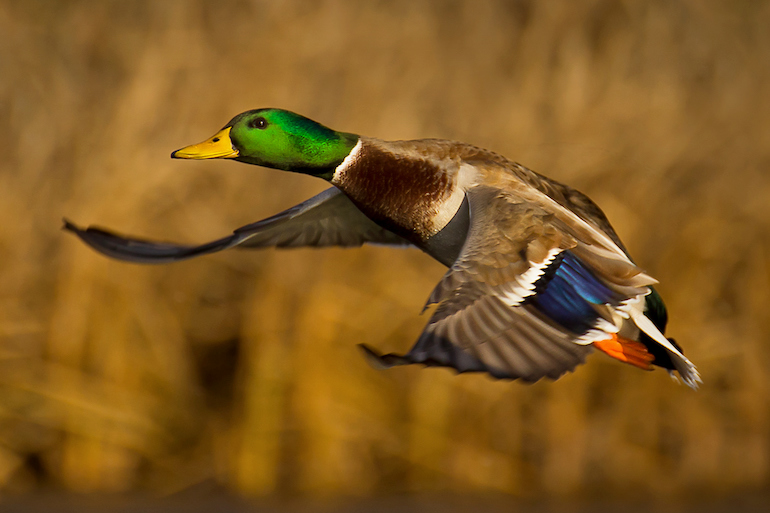
While mallards are the predominant dabbler species targeted by Southern waterfowlers, many of the spreads detailed here draw more than just greenheads. (Shutterstock Image)
Fooling waterfowl consistently means adapting to the variables that present themselves both in the field and on the water. Ultimately, how convincing your decoy spread is will either make or break a hunt. Here, we outline four decoy spreads, each proven to dupe even the wariest flocks under most conditions.
THE CROP CIRCLE
This spread is effective for hunting ducks in a harvested agricultural field. Unlike many field decoys setups, the Crop Circle draws ducks in extremely well even with light and variable winds.
Ducks and geese tend to decoy into the wind, but harvested grain fields are so attractive that ducks might drop from the sky from any direction. This spread keeps ducks out in front where shooting them is easiest.
Puddle ducks that drop into an agricultural field that already has ducks on it will land behind those ducks rather than in front of them. They also like to land near individuals and small groups that have moved away from the main flock. Anyone who has had a floating decoy drift off during a water hunt has likely noticed this behavior, and it also occurs in fields.
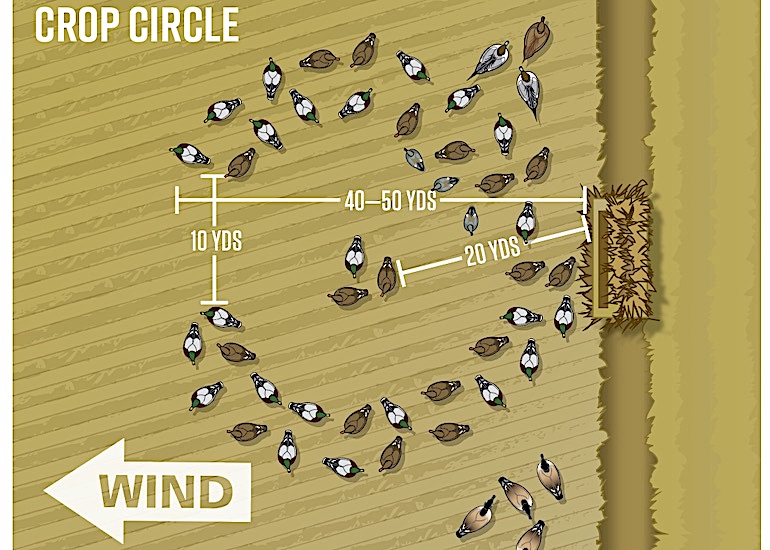
The decoys are set in a circle with a small flock or an individual decoy in the center. No matter which way the wind is blowing, ducks will either head for the upwind, inside edge of the circle of decoys to land at the tails or they’ll target the small flock (or single) in the center. A narrow gap in the downwind side of the circle entices ducks to enter the circle at that location.
Mallards are usually the mainstay species for a field hunt. However, setting small flocks of other ducks, such as gadwalls and pintails, upwind on the hunter’s shooting shoulder side, can entice these other ducks to decoy while saving the best shooting angle on the shooter’s strong side for decoying mallards.
If Canada geese are in the area, setting a small group of goose decoys away from the main circle of duck decoys and on the side opposite the secondary duck decoys can provide a bonus opportunity.
THE FISHHOOK
One of the most reliable decoy setups on land or water is the Fishhook, also known as a “J Spread.” The Fishhook works best when the wind is angling over the shooter’s shoulder or parallel to the bank. The shank of the fishhook extends downwind.
Canada geese are the primary targets with this setup. If secondary species (i.e., white-fronted or snow geese) are in the area, setting small groups of decoys for them upwind, outside and away from the point of the hook, might entice them to drop in.
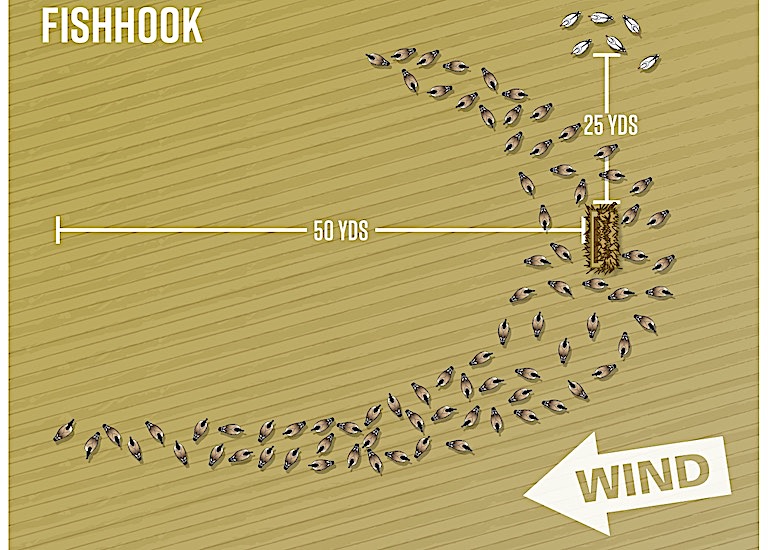
It’s important to set this spread well away from any tall cover, including trees, cane, cattails and fencerows. Canada geese might circle a spread several times before taking a long-approach flight path as they decoy from downwind. They’ll shy away from any tall object they have to pass over while circling and might balk if any tall cover is near the shank of the hook during their final approach. Even a single bush can cause them to change their minds and flare away.
The blind should be at the apex of the hook bend. Geese will land anywhere along the inside of the bend, so being situated for shooting at its center provides the best opportunity no matter the approach angle.
THE GAPPED FISHHOOK
This spread is best for hunting diving ducks that have been hunted hard and are blind wary. The Gapped Fishhook is set up so the long shank of the hook runs away from the boat or bank blind positioned at the hook’s point.
Diving ducks are seemingly hypnotized by the long line of decoys leading to the hook bend. However, the line must be perfectly straight, with decoys spaced evenly 4 or 5 feet apart. Using gang rigs, also called longline or trotline rigs, helps to maintain the straight line and keeps decoys spaced evenly.
The line can be 100 yards or longer, extending far downwind. Passing ducks locate the end of the line and fly along it until they reach the bend in the hook, where they decoy to the head of the decoys. However, if there is any gap or division in an otherwise straight line of decoys, decoying divers might land in the gap(s) and out of gun range.
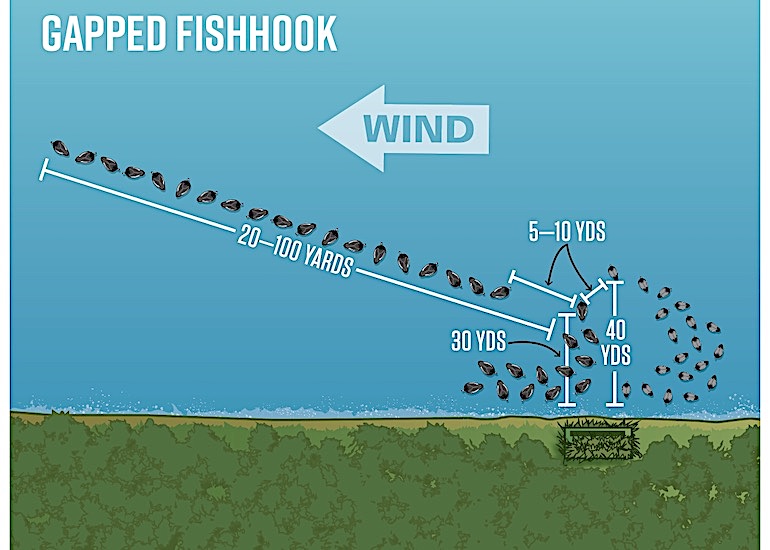
Diving ducks tend to decoy to the head of a rig because of the way they feed. After swimming submerged and feeding on the bottom, birds at the rear of the flock will surface and leapfrog over ducks feeding in front of them because the easiest-to-find food has been eaten.
A gap should be left at the end of the straight shank just before the hook bend. Diving ducks can decoy very close to the water, and the gap keeps the hunter from shooting his decoys. Another flock of diving ducks should be set to attract secondary birds.
For early-season spreads, ring-necked duck decoys can serve for the main body and scaup for the secondary species, but species composition should match the ducks seen in the area. The secondary species decoys are set with the hook point facing outward from the blind, leaving a gap between the two bodies of decoys.
This leaves another open area where you don’t have to worry about shot striking the decoys. Ducks will attempt to land at either gap or at the head of either body of decoys, depending upon the species.
THE DOUBLE V
The Double V spread is a great water setup for puddle ducks, and it can attract primary and secondary species as well as oddball ducks. The first V is set slightly upwind, with the wind blowing parallel to the bank. The second V of decoys is set 10 to 20 yards behind or downwind of the first V. In November, most Southern waterfowl hunters are served well by using mallards and green-winged teal decoys to fill out these two Vs.
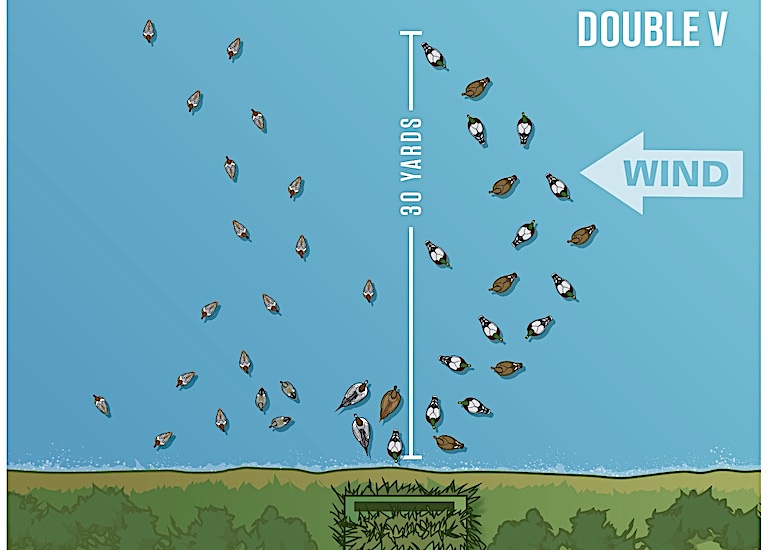
Setting a single teal and a single mallard decoy in the gap between the two Vs gives singles and small flocks a landing target. Puddle ducks usually land behind the decoys, rather than in front of them like divers do. This setup works well when puddle ducks are drawn to the inside angular bends of the Vs or to the single decoys in the gap(s) between them.
Other secondary decoys can be set near the blind in the gap between the two Vs of primary decoys. These can include black ducks, pintails, gadwalls or confidence decoys like coots, depending upon the various species that are in the area. Even diving ducks may be attracted to decoys set in this location. The idea is to give them a landing target within the large Vs that constitute the main attraction.
FRESHEN UP YOUR SPREAD
Time for a decoy upgrade? Check out these four fakes.
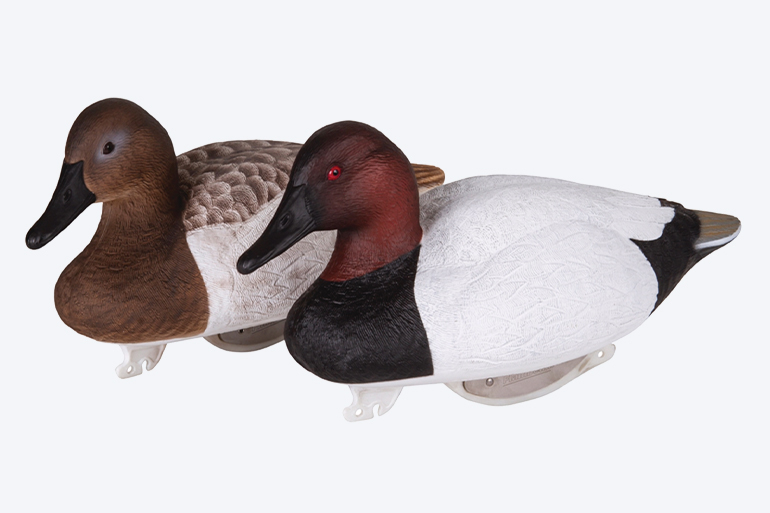
Flambeau Gunning Series Canvasback decoys pair the round-bottom design of old-time, hand-carved decoys with a modern, skeg-style keel for a lifelike ride under any water conditions, even in the shallow waters of flooded farm fields. The plastic outer shell is quiet, and the interior is foam-filled for durability. The patented UVision finish reflects the real ultraviolet plumage signature that ducks see. ($139.99/six; flambeauoutdoors.com)
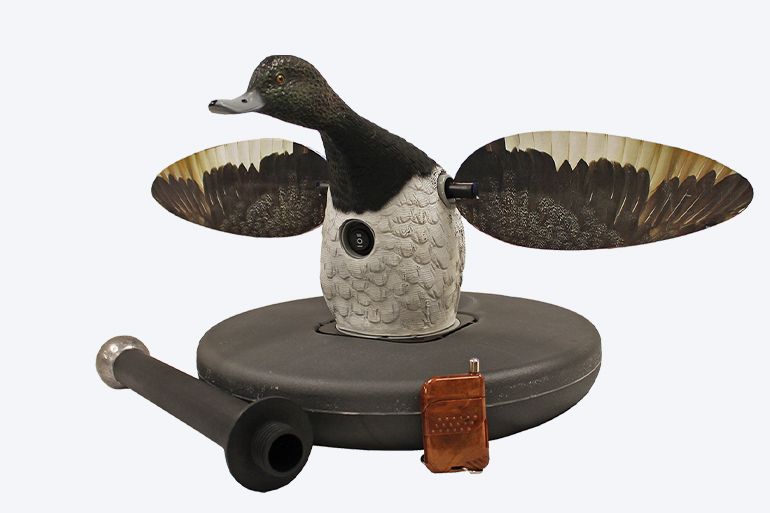
Mojo’s Elite Series Floater decoys solve the problems associated with setting spinning-wing decoys on stakes by replacing the stakes with easy-to-install floating plastic bases. Each decoy includes a remote control. The float has a removable 11-inch bar with a 14-ounce weight that stabilizes it in rough conditions. Available in mallard, bluebill and redhead drakes. ($139.99; mojooutdoors.com)

Tanglefree’s 60 Pack of Lesser Canada Skinny silhouette decoys contains 40 upright, 10 walker and 10 feeder geese for customizable, ultra-realistic spreads in a number of scenarios. All 5-dozen decoys feature flocked heads for improved realism. A Flight Series decoy bag in Optifade Marsh camouflage is included for easily transporting the lightweight dekes to and from the X. ($434.99; tanglefree.com)








































